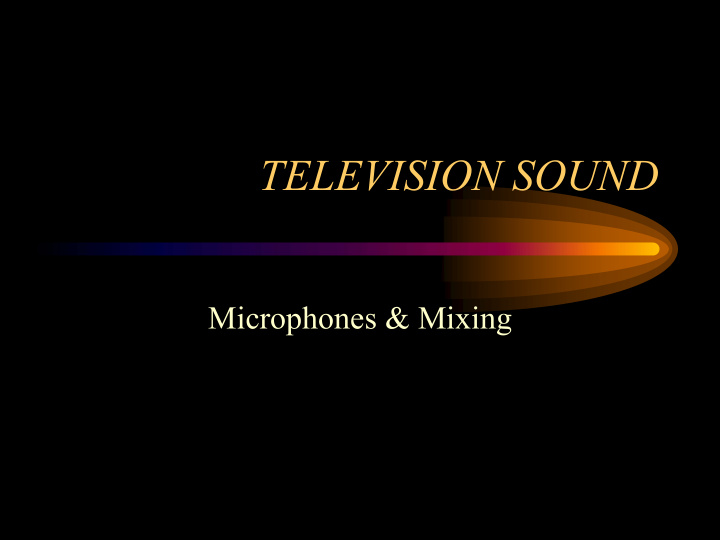



TELEVISION SOUND Microphones & Mixing
Microphones • pick-up quality depends on several variables – placement – acoustic environment – design & selection
MICROPHONE TYPES • Dynamic (moving coil or ribbon) – A microphone that operates by electromagnetic induction to generate an output signal. – RUGGED & INEXPENSIVE
Let’s get graphic Sound moves the diaphragm and the attached coil of wire moves in the field of the magnet. The generator effect produces a voltage which "images" the sound pressure variation.
DIAPHRAM • Like the Human Ear • Moves freely in response to pressure – like barometer – responds to atmospheric changes on its surface
Size of Diaphram • SMALL Diameter – better high Frequency response – bright / brilliant sound – not much low frequency response – long-low frequency waves pass by capsule – bass notes cause little movement of diaphram • HEAVIER DIAPHRAM – less able to respond to quick atmospheric changes
MICROPHONE TYPES • Condenser – operates on electrostatic principle (rather than electromagnetic) • Head (capsule) consists of two very thin plates - one moveable & one fixed • two plates form a capacitor - electrical device capable of storing an electrical charge. • Sound pressure sensitive (air between plates) • must be polarized with DC current (48V Phantom power)
Graphics Again !!! •Head (capsule) consists of two very thin plates - one moveable & one fixed •two plates form a capacitor - electrical device capable of storing an electrical charge. •Sound pressure sensitive (air between plates) must be polarized with DC current (48V Phantom power)
Advantages / Disadvantages •Best overall frequency response makes the microphone a good choice for many recording applications •Detailed sound Quality / High sensitivity •Expensive •May pop and crack when close miked •Sensitivity make them prone to distort in high volume work •Requires a battery or external power supply (Phantom Power)
The Electret Condenser Mic • uses a special type of capacitor which has a permanent voltage built in during manufacture. This is somewhat like a permanent magnet, in that it doesn't require any external power for operation. • Examples – Video camera mics – Computer mics
DIRECTIONAL RESPONSE • Mics differ in the way they respond to sounds coming from different directions • Polar Pattern or Polar Response
Mic Pick-up Patterns Graph plots relative sensitivity in dB versus angle of sound incidence in degrees
Three Major Polar Patterns • Omnidirectional • Bidirectional • Unidirectional
Omnidirectional Sensitive to sounds arriving from all directions
Bidirectional • Sensitive to sound arriving from front and rear • Rejects sound from sides
Unidirectional • Most sensitive to sound arriving in one direction
Cardioid Heart Shaped (Cardio) •Accepts sounds arriving from a broad angle in front •6db less sensitive at sides •15-25dB less sensitive at rear
Balanced vs. Unbalanced • Balanced – minimizing unwanted noise from interference in audio cables • any interference picked up in a balanced cable is eliminated at the point where the cable plugs into a sound mixer or other equipment.
Unbalanced • hot line carries the signal and an earth (ground) line.
Balanced When the cable is plugged into an input (on a mixer or other equipment) the hot and cold signals are 180 degrees out of phase, but at the input stage they are put "back in phase"
Balanced XLR
1/4” TS (Tip / Sleeve) MONO
1/4” TRS (Tip –Ring- Sleeve) STEREO
RCA / PHONO PLUG
Mics & Such • Lavaliere (lav) • Boom • Hand held • Desk • Wind Screen / Diffuser • Audio Snake • Mic Splitter
STEREO MICING • 2 identical microphones spaced apart • designed to sound just like the ear hears.
Supplemental Web Site • TV Sound: The Basics • Microphones - Part 1 • Microphones - Part 2 • Audio Control Devices • Recording / Playback Devices
Types of Microphones
Free Field (Hand Held) • Meant to be used away from reflective surfaces • Most mics are considered “Free Field”
Boundry Mics • Designed to be used on a surface – Floor – Table – Wall – Piano lid • Drama • Musical • Small ensembles
STEREO MICS • Two mic capsules in one housing • Two XLR’s (L-R) • Most XY Patten – Coincident pair
Shotgun Microphone • Long Tube Shaped • Highly directional • Maximum rejection of unwanted sound • Most uses – Video dialog – News gathering – Outdoor recording • Windscreen or muff
Parabolic Microphone • Directional • Sensitivity
Lavaliere • Lapel Mic • Condenser – Omni – Uni • Phantom Power • Battery
Wireless • Lapel • Handheld • AC &/or Battery • Transmitter / Receiver
Stands / Booms • Desk • Floor • Boom • Studio Boom • Handheld boom
Mult-Box Active Passive
SNAKE
Recommend
More recommend